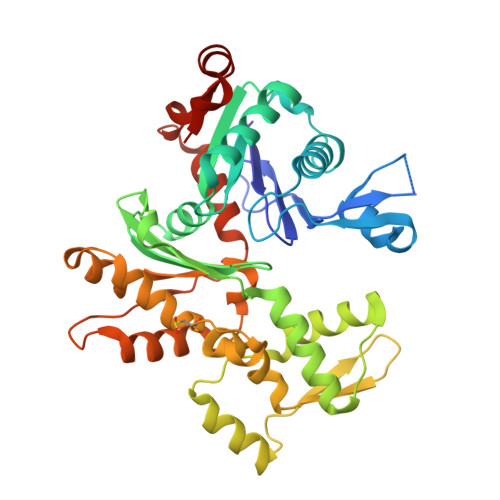Molecular and Structural Basis for Redox Regulation of beta-Actin.
Lassing, I., Schmitzberger, F., Bjornstedt, M., Holmgren, A., Nordlund, P., Schutt, C.E., Lindberg, U.(2007) J Mol Biol 370: 331-348
- PubMed: 17521670
- DOI: https://doi.org/10.1016/j.jmb.2007.04.056
- Primary Citation of Related Structures:
2OAN - PubMed Abstract:
An essential consequence of growth factor-mediated signal transduction is the generation of intracellular H(2)O(2). It operates as a second messenger in the control of actin microfilament dynamics, causing rapid and dramatic changes in the morphology and motile activity of stimulated cells. Little is understood about the molecular mechanisms causing these changes in the actin system. Here, it is shown that H(2)O(2) acts directly upon several levels of this system, and some of the mechanistic effects are detailed. We describe the impact of oxidation on the polymerizability of non-muscle beta/gamma-actin and compare with that of muscle alpha-actin. Oxidation of beta/gamma-actin can cause a complete loss of polymerizability, crucially, reversible by the thioredoxin system. Further, oxidation of the actin impedes its interaction with profilin and causes depolymerization of filamentous actin. The effects of oxidation are critically dependent on the nucleotide state and the concentration of Ca(2+). We have determined the crystal structure of oxidized beta-actin to a resolution of 2.6 A. The arrangement in the crystal implies an antiparallel homodimer connected by an intermolecular disulfide bond involving cysteine 374. Our data indicate that this dimer forms under non-polymerizing and oxidizing conditions. We identify oxidation of cysteine 272 in the crystallized actin dimer, likely to a cysteine sulfinic acid. In beta/gamma-actin, this is the cysteine residue most reactive towards H(2)O(2) in solution, and we suggest plausible structural determinants for its reactivity. No other oxidative modification was obvious in the structure, highlighting the specificity of the oxidation by H(2)O(2). Possible consequences of the observed effects in a cellular context and their potential relevance are discussed.
Organizational Affiliation:
Department of Microbiology, Tumor Biology, and Cell Biology, Karolinska Institutet, SE-171 77 Stockholm, Sweden.


















